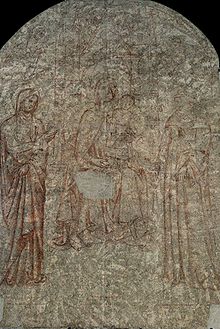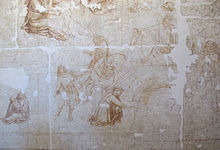| Sinopia | |
|---|---|
| Hex triplet | #CB410B |
| sRGBB (r, g, b) | (203, 65, 11) |
| HSV (h, s, v) | (17°, 95%, 80%) |
| CIELChuv (L, C, h) | (48, 118, 19°) |
| Source | [1] |
| ISCC–NBS descriptor | Vivid reddish orange |
| B: Normalized to [0–255] (byte) | |



Sinopia (also known as sinoper, named after the now Turkish city Sinop) is a dark reddish-brown natural earth pigment, whose reddish colour comes from hematite, a dehydrated form of iron oxide. It was widely used in Classical Antiquity and the Middle Ages for painting, and during the Renaissance it was often used on the rough initial layer of plaster for the underdrawing for a fresco. The word came to be used both for the pigment and for the preparatory drawing itself, which may be revealed when a fresco is stripped from its wall for transfer.
During the Middle Ages sinopia in Latin and Italian came to mean simply a red ochre. It entered the English language as the word sinoper, meaning a red earth colour.[1]
Sinopia is a colour in various modern colour systems.
- ^ Daniel V. Thompson, The Materials and Techniques of Medieval Painting, (1956)' Dover Publications, New York, p. 98